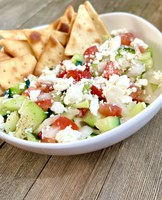Prairie Fare: Are you on the cutting edge with your knife skills?
(Click an image below to view a high-resolution image that can be downloaded)
By Julie Garden-Robinson, food and nutrition specialist
NDSU Extension
“We are underdressed for this restaurant,” our older daughter said.
She was wearing shorts and a t-shirt on the warm day. Our younger daughter was dressed similarly.
“There is no dress code. They are all students in this culinary school,” I commented.
An attentive instructor was watching from the sidelines.
We were on a family vacation, and I had heard about the culinary school from a friend. We took a chance and parked nearby. Fortunately, they had seats available for lunch.
The students made room for us to have a five-course meal with a tea service. We were seated at a table with white tablecloths and cloth napkins folded elaborately.
The culinary students were scurrying about the dining area. I think we had five students helping us, and the attention greatly entertained our daughters.
This was quite a fancy experience for my kids, and they remember it 10 years later.
I remember the perfectly cut vegetables and artistically arranged plates by the soon-to-graduate students. I am sure the students spent a lot of time perfecting their knife skills.
I have taken some courses on culinary skills, and assembling a “knife kit” is among the costs of the course. Learning various knife cuts is a key to mastering recipe creation.
How much do you know about the terminology related to cutting? Many of these words come from French cuisine, by the way. I have added a few of the phonetic pronunciations.
Here’s your word bank: A. bias, B. batonnet (“baw-tow-NAY), C. brunoise (“bru-NWAZ”), D. chiffonade (“shi-fuh-NAYD”, E. dice, F. julienne (“joo-lee-EN”), G. mince.
- What is name of the ribbonlike cuts typically used to slice herbs? Stack the herb leaves (such as basil), roll the stack, slice into thin ribbons and unroll.
- This is the name of the cut when you finely chop garlic or ginger. These are not as precise sizes as other cuts.
- This style of cut results in the formation of even matchstick-sized pieces. Ideally, these cuts are 1/8 inch wide by 2 1/2 inches long.
- These are cubes of evenly cut vegetables. These cuts are classified as small, medium or large.
- This is the name for vegetables cut into somewhat thick sticks (such as carrot sticks).
- This is a type of cutting where you cut vegetables diagonally, instead of into round “coins” or “rondelle.”
- These are tiny pieces of vegetables cut into perfect 1/8-inch cubes.
Impress your family with any of the new terms you learned. Here are the answers: 1. D; 2. G; 3. F; 4. E; 5. B; 6. A.; 7. C
Before practicing these cuts, keep these knife safety tips in mind.
- Sharpen your knives. Sharp knives are essential for cutting and chopping. You can have them professionally sharpened periodically in addition to using home-sharpening equipment.
- Choose the right knife for the task.
- Be sure to pick up knives by the handle and not the blade.
- When carrying a knife from one place to another, carry it with the blade by your side. Do not carry a knife with the knife blade pointing ahead of you.
- Use an appropriate cutting board made from plastic or wood. Ideally, your cutting board will have “gripping feet.” Try placing a damp cloth under the board if needed. Glass or marble cutting boards are not recommended because they can dull your knife.
- When cutting, hold the knife properly and protect your fingers of the hand holding the carrot or apple by curling your fingers.
- If your knife falls, do not try to catch it.
- Do not put knives in soapy water for unsuspecting people to accidentally cut themselves.
Here’s a summery recipe to enjoy with fresh vegetables. Try cutting into different-sized dice cuts.
Cucumber Salsa
3 cups diced cucumbers
1/2 to 1 cup diced red onion
1/2 cup diced tomatoes
1/2 cup feta cheese, reduced fat
Dressing:
2 lemons
1/4 cup extra virgin olive oil
1/2 teaspoon salt
Chop cucumbers, onions, tomatoes and olives, then add to a large bowl. Mix in feta cheese. Make dressing with the juice of lemons, olive oil and salt. Toss together mixture with dressing. Serve with pita chips.
Makes six (3/4 cup) servings. Each serving of salsa has 125 calories, 10 grams (g) fat, 3 g protein, 8 g carbohydrates, 2 g fiber and 290 milligrams sodium.
(Julie Garden-Robinson, Ph.D., R.D., L.R.D., is a North Dakota State University Extension food and nutrition specialist and professor in the Department of Health, Nutrition and Exercise Sciences. Follow her on Twitter @jgardenrobinson)
NDSU Agriculture Communication – May 26, 2022
Source: Julie Garden-Robinson, 701-231-7187, julie.garden-robinson@ndsu.edu
Editor: Elizabeth Cronin, 701-231-5391, elizabeth.cronin@ndsu.edu




